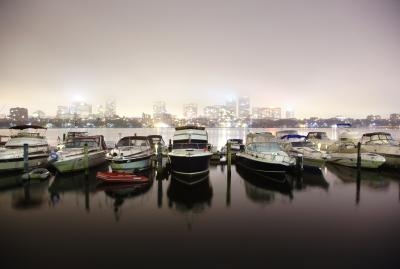
Many people lack the knowledge in knowing the difference between marine and car engines. The main difference occurs because of the environment each engine functions within -- water for the marine engine and the road for the regular passenger car. Generally, boat engines have more complexity and modifications, which allow them to hold up better under harsher circumstances. A number of systems and components have been added or modified in boat engines to boost their performance, ensure safety and resist the corrosive effects of water.
The water-circulating pump on a marine engine functions in an "open" cooling system where the pump draws raw or outside water into the engine, unlike a "closed" cooling system in a car engine, which has anti-freeze or coolant constantly contained. The marine engine expels incoming water overboard through an exhaust port when it finishes with it. Marine pump impellers usually have a ceramic seal, a backing plate of stainless steel and a bronze or rubber impeller that resists corrosion from fresh or saltwater. Car water pumps have regular steel impellers that would corrode in a marine environment.
Car engines typically expel fuel vapors from the engine compartment to the outside air through numerous openings in the chassis. Boats have sealed engine compartments, which hold fuel vapors within a closed engine box or engine room. A boat engine has special seals, insulation and extra vents on the starter, distributor and alternator. Boats have bilge ventilator fans to evacuate dangerous fuel vapors in the engine compartment -- a procedure used before starting the boat engine. Boat engines risk explosion from any stray or leaking spark.
Most boat engines come equipped with carburetors that have J-type fuel bowls. These bowls have special features and construction that allow for heavy vibrating, pitching up and down and yawing from side to side. Otherwise the fuel would be splashed out of the fuel barrels. Car carburetors typically have box-like or round fuel bowls that keep the fuel level constant for the lesser angles that the car experiences during driving.
Boat engines have to deliver most of their power or torque during the lower end of the throttle range. Therefore they use a single forward transmission gear to propel the boat from a standing stop to full throttle. The boat engine camshaft lobes are ground to increase horsepower at lower levels, rather than high rpm. Boat engine valves must be timed to shorten the overlap between the exhaust and intake when they open at the same time. Otherwise water can be drawn back into the combustion chamber from the exhaust, severely damaging the engine.
Boat engines use heavier constructed truck engine blocks, which have crankshafts held by a four-bolt main cap system. Car engines typically have two-bolt main caps, since they experience less stress and power demands. This means that the boat engine main bearings, rod bearings and camshaft bearings will be heavier in construction. A boat engine does not have the luxury of cruising over a hard surface like a car engine; boat engines always perform under constant load, putting more stress on the main engine parts.
Many boat engines have "wet" exhaust manifolds. A wet exhaust manifold has a regular manifold which has ports to expel burnt exhaust gases, but also has an internal water pipe that cools the exhaust gases so they do not reach critically high temperatures. Boat exhaust manifolds reach higher temperatures than car exhaust manifolds because of their enclosed nature and need to run much harder under load. Car exhaust manifolds run much cooler because of the incoming air drafts that circulate inside the engine compartment.
Boat engine gaskets have special, high-quality construction that make them resistant to higher temperatures and saltwater corrosion. They must also seal better than car engine gaskets, since they exist in a water environment where moisture causes heavy rust and deterioration.